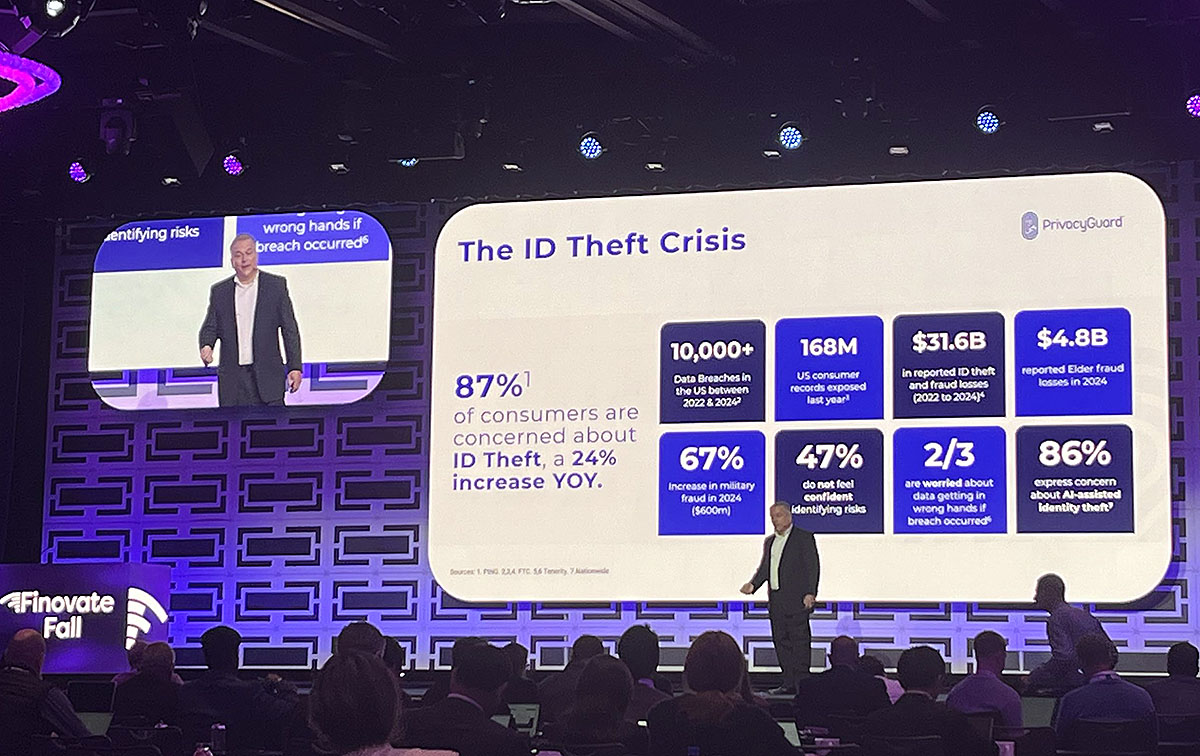Credit card delinquencies are at their highest level in decades. Personal savings have dipped to historic lows. Synthetic identity fraud has surged more than 300%, and consumers increasingly worry about falling victim to identity theft.
Those numbers explain why fraud prevention has become fintech’s defining frontier. At FinovateFall 2025, the trend lines came sharply into focus: the firms that win the next wave of digital finance will be the ones that make customers feel safe.
Why has fraud prevention become fintech’s top priority?
For years, fintech innovation revolved around convenience and speed. Today, the priority has shifted to security and trust. Capabilities and ease of use have always been at the heart of fintech marketing, but now users are just as keen to know how the solutions they use will keep them safe.
Across the industry, companies are investing in biometric verification, real-time transaction monitoring, and advanced KYC/AML (Know Your Customer / Anti-Money Laundering) tools. Synthetic ID detection and scam protection have moved from nice-to-have to non-negotiable.
In this environment, any product without robust fraud defenses risks losing both customers and investors. In other words, data security has become a foundation for growth.
How has AI changed the balance of power between fraudsters and institutions?
Artificial intelligence now sits on both sides of the fraud equation. Fraudsters are using it to create deepfakes, automate phishing scams, and generate convincing synthetic identities. At the same time, financial institutions deploy AI to spot anomalies, monitor transactions, and predict fraud before it happens.
The most effective firms treat AI as a “thinking partner.” They combine machine efficiency with human oversight, ensuring decisions remain explainable and defensible. Growth-minded fintechs put this tech-enabled human expertise on display. When a provider shows how it prevents fraud, it wins more trust.
The most innovative institutions are realizing that no one can tackle this alone. Consortium-based data sharing, where banks and fintechs pool intelligence about fraudulent applications and transactions has proven effective in several international markets.
While the U.K. has made progress in this model, the U.S. still operates in silos. Expanding collaboration here could dramatically improve detection and reduce losses. The takeaway: in modern fraud defense, cooperation is a competitive advantage.
What does regulation mean for innovation in fraud defense?
Fraud prevention is not only a technology challenge. It is also a regulatory and policy issue. Panelists at FinovateFall 2025 discussed how federal policymakers are often slow to adapt, while state-level authorities and local judges may be closer to the realities of fraud cases. Some regulators are experimenting with risk-based approaches that could give firms more flexibility while holding them accountable for results.
The discussion also touched on reputational risk. Banking is still a conservative industry, and institutions remain cautious about how their fraud strategies are perceived by customers, regulators, and investors. Panelists argued that transparency will be key. Firms that acknowledge the scale of the problem and demonstrate credible defenses will be better positioned than those that downplay the risks.
Why are investors treating fraud prevention as a valuation driver?
Fraud prevention was also a thread in the investor conversations. The “Investor All Stars” panel at FinovateFall addressed the state of fintech funding, noting that U.S. investment has risen slightly in recent quarters but remains well below 2022 levels. Venture capitalists described a two-track market: deals in AI and fraud prevention are attracting attention, while pureplay fintechs without strong defenses are struggling.
Investors stressed that fraud protection is no longer just a technical feature. It is a material part of a company’s valuation. Startups that cannot show robust defenses risk losing customer trust and face a harder time raising capital. By contrast, firms that embed fraud prevention into their growth story are more attractive to both investors and potential acquirers.
The conversation also touched on exits. IPOs remain challenging in the current market, making M&A a more likely path for many fintechs. Here again, fraud defenses matter. Banks considering acquisitions are weighing whether it is more efficient to build fraud solutions in-house or buy them through strategic deals. Startups with proven fraud prevention capabilities may find themselves better positioned for acquisition.
What comes next for fintechs and financial institutions?
The industry is moving toward a new equilibrium: seamless digital experiences that don’t compromise on protection. The firms that succeed will be those that:
- Integrate prevention into every layer — from onboarding and product design to client communication.
- Keep AI accountable — balancing automation with explainability.
- Collaborate widely — sharing intelligence without sacrificing competitive edge.
Fraud prevention has become a cornerstone of customer trust, investor confidence, and sustainable growth.
